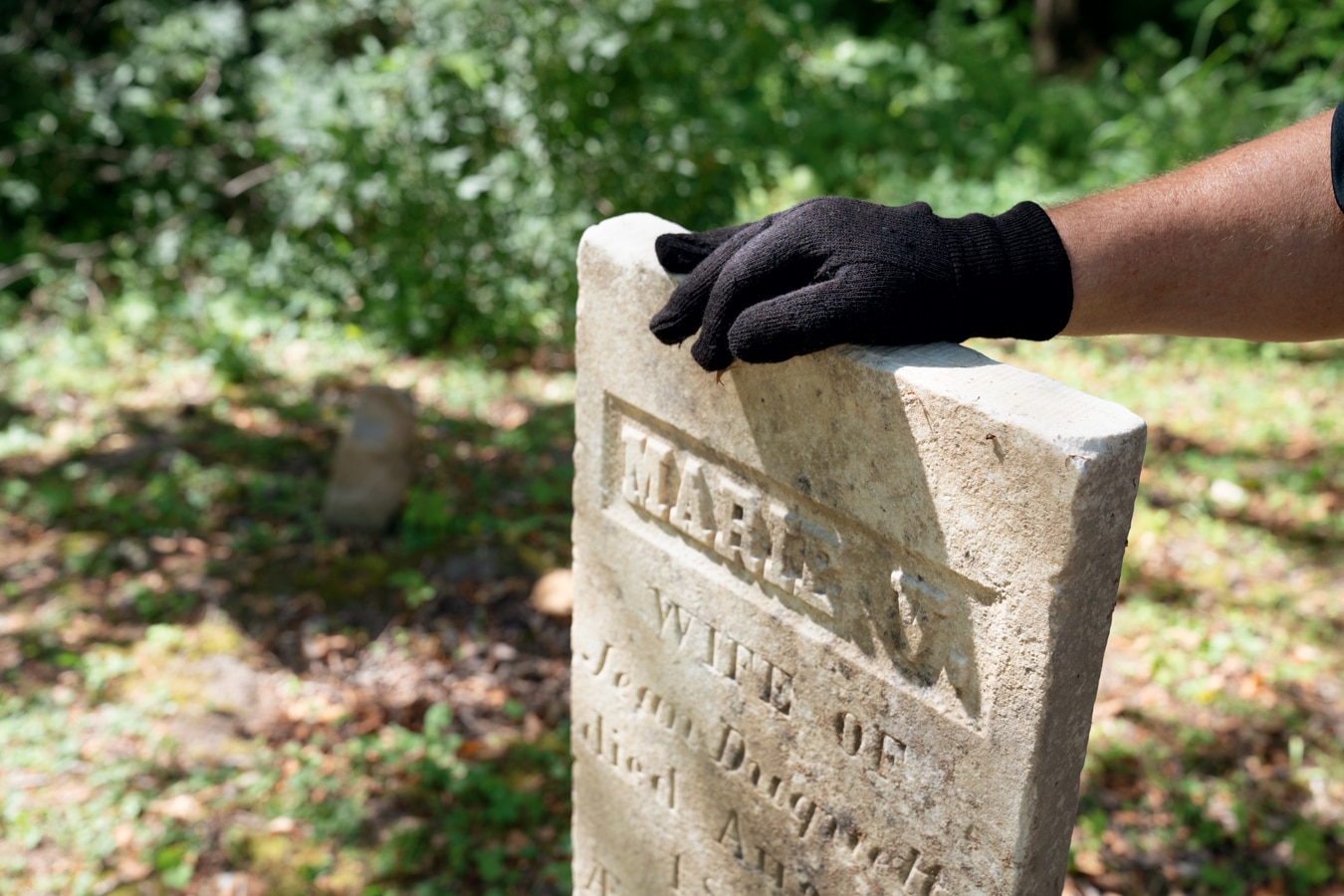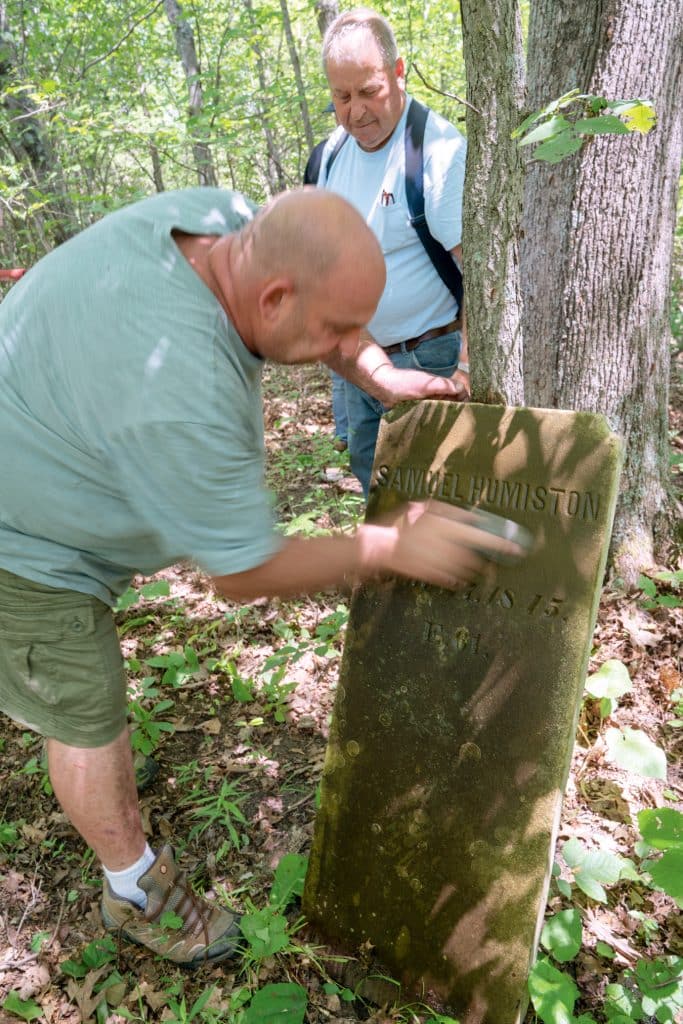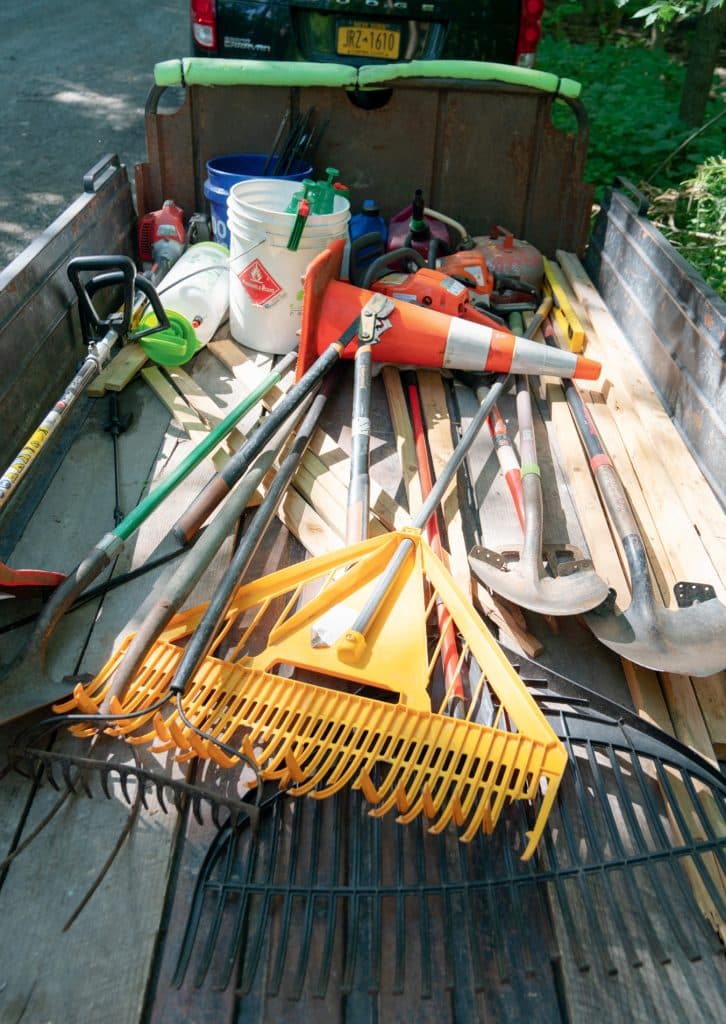The “Headstone Brigade” Rescuing Vermont’s Rural Cemeteries
Since the Vermont Old Cemetery Association was established in 1958, a dedicated team of history buffs, dutiful descendants, and good neighbors have crisscrossed the Green Mountains in order to “encourage the restoration and preservation of neglected and abandoned cemeteries in the State of Vermont.”

A member of the Vermont Old Cemetery Association for more than two decades, Barry Trutor rests a work-gloved hand on a 19th-century tombstone in West Haven, Vermont, population 285.
Photo Credit : Bill McDowellBy Leith Tonino
Early on a drizzly gray Saturday at the close of summer, a cemetery I had driven past countless times over the years and noticed only peripherally became something else entirely, something vivid and intriguing. As I strolled its slick grass, it wasn’t just the dead who greeted me, inviting me in and sparking my curiosity. Among the Lussiers and Gauthiers and Gravells and Graces and Harveys and Milos and Goulets and Renauds and Beauchamps and Borias—in addition to Patrick Butler (d. 1860, 15 months old) and the sister Nellie he never met (d. 1876, nine months old)—a dozen flesh-and-blood volunteers were busy among the headstones, commencing a long morning’s labor.
One guy shoveled sure-pack gravel mix into his wheelbarrow. A second guy, carrying a heavy rock bar, said to a third guy, carrying a carpenter’s level, “What’ve we got for straps? We’re in big trouble without straps.” John Deere was present, as was a Bobcat track loader loaned by a local landscaper. There were wisecracks about hernias; chitchat about clay soil and poor drainage and frost heaves toppling 700-pound angels; laments about families that moved west, vanished a century ago, left nobody behind to yank weeds and plant plastic flowers. The volunteers ranged in age from teen to septuagenarian, in occupation from farm wife to real estate developer, in footwear from flimsy sandals to beefy hiking boots. Two were cousins. A couple were church ladies. The majority were strangers.
OK, but here’s the image that really did it. Kneeling beside a listing mini obelisk, a young woman was scrubbing, scrubbing, scrubbing at a grimy, lichen-splotched epitaph with what appeared to be a standard-issue toothbrush, pausing occasionally to fire a spray bottle filled with the biological solution D/2 (the same product that keeps Arlington National Cemetery spiffy). She had no family ties to the person buried below her, yet nevertheless she held her awkward, hunched position—a position that, to my eye, resembled a kind of bow, a kind of earnest, elbow-grease prayer. She was seemingly oblivious to the increasing precipitation, sheltered by her own private umbrella of quiet focus. She was smiling.
Headstone righting, repair, and cleaning. St. Peter’s Cemetery. Vergennes, Vermont. 8:00 a.m. to 1:00 p.m. That was the posting on the Vermont Old Cemetery Association website that had caught my attention and led me to this niche community. Since VOCA was established in 1958, history buffs and genealogy freaks and dutiful descendants and nature lovers and plenty of helpful civic-minded folk have crisscrossed the Green Mountains, their truck beds heaped with tubes of two-part epoxy and pruning shears, in order to (as Article II of the outfit’s official constitution puts it)“encourage the restoration and preservation of neglected and abandoned cemeteries in the State of Vermont.”

Photo Credit : Bill McDowell
Encouragement takes primarily the form of hands-on assistance, though it also manifests as shared technical expertise (how does one reassemble a time-shattered slate grave marker?) and cash grants ($330 for five large stones repaired in Glover’s Westlook Cemetery, $750 for tree removal and trimming in Granville’s South Hollow Cemetery). According to VOCA’s autumn calendar, members would tackle Pawlet, Rutland, and Shaftsbury, then round out the year with a biannual meeting that doubles as a chicken-and-biscuits luncheon. But first, five miles down the road from my home in Ferrisburgh, St. Peter’s was scheduled to receive some TLC. For reasons I couldn’t name, I wanted to attend.
Maybe it had to do with a yellowy newspaper clipping I’d recently stumbled on, a 1973 interview with VOCA’s founder that anticipated, in a way, the toothbrush woman’s smile. A professor of English at UVM and an author passionately engaged with folklore, Leon Dean,born in Bristol, Vermont, in 1889, told the reporter, “I’ve done quite a number of things in my life, but this has given me just about the most satisfaction of anything.” He was referring to“saving” cemeteries that had suffered the “atrocity” of neglect, a pastime that doesn’t jibe withthe usual self-interested, utilitarian calculus of modern America. Lavish your energy on the off-plumb, the overgrown, the forgotten? Kneel in the rain when you could be staying dry or taking care of your own land? Clouds scudding low, the weather coming and going and coming, I wandered with my hood up, asking everyone why they were here.
Jeanne Jackson, pink blouse, black rubber galoshes, woke at 5 a.m. to make sandwiches for the group: “This cemetery was in horrible shape, not mowed, water pooling on my parents’ grave. Today’s our third session in five years, and it looks 100 percent better than before, but each spring there are more stones that need to be treated. It’s not cheap to hire a contractor to bring in a machine and right a stone. VOCA saved us tens of thousands of dollars by showing us how to do the fixes ourselves, and now I volunteer at cemeteries around the county out of gratitude.”
Jeff Bostwick, sunburned and muddy, his fifth VOCA outing of the year: “My first time was in Milton, graves dating to the late 1700s, the Revolutionary War era. That was a powerful experience. I’m a seventh-generation Vermonter and consider all these people my family. It’s tangible, honoring them. You can see your progress. And by evening, I’m exhausted, barely able to get off the couch. Seriously, I wish I’d discovered this 20 years ago.”
David Austin, floppy-brimmed hat, serves on the Vergennes City Council, lives across the street from his childhood house and routinely walks through St. Peter’s at night: “Do you know James Kunstler’s book The Geography of Nowhere, about suburbia and sprawl?You can’t wave a magic wand and create a sense of place. I’ve travelled a lot overseas and there’s always somebody doing this type of maintenance, even at the tiniest cemetery. It has to do with integrity of place, demonstrating that this is a specific place, not a generic place, and it’s worth valuing. I guess it’s my turn?”

Photo Credit : Bill McDowell
After an hour of talking and feeling rather ashamed of a sweatless brow and dirtless fingernails, I decided it was my turn. Austin, Bostwick, and three others were preparing to lift a headstone with the Bobcat and reset it on the granite base (previously tilted, freshly leveled) from which it had fallen. The stone was a behemoth, and without the precious tow straps, the job would have been big trouble indeed. Fifteen minutes of tinkering and strategizing delivered us to the moment of don’t-botch-it teamwork, a blue-collar ballet.The Bobcat operator gingerly elevated his forks.Four of us circled the dangling, swaying stone and guided it toward the base with 40 sensitive fingertips. A voice said, “Gentle, gentle.” A voice said, “Left, left, left a titch.” A voice said, “Eeeeasy.” And then—an inch from landing, half an inch, less—the stone was freestanding, anchored by gravity, secure.
At that precise instant of contact, Whoa! The overcast sky broke, the sun emerged, and an electric tingle raced the length of my spine. I had been thinking in terms of a fun engineering problem, like dragging a Prius from a winter ditch, and the sudden notion that we had hoisted the deceased back up into the light was an unexpected shock.
Did we hoist the deceased, via a granite proxy, up into the light? Is that what happened? Perhaps I was mistaken. Perhaps I’d merely pinched a nerve in my lumbar. I recalled a favorite quote from the novelist Vladimir Nabokov: “Let us worship the spine and its tingle.”
The following week, I emailed Barry Trutor, a VOCA veteranin the process of “rescuing” five derelict cemeteries on a 3,800-acre Nature Conservancy preserve in a particularly overgrown nook of West Haven, Vermont. Three of the cemeteries were complete—notably Galick, “the gem”—and the remaining two would be dealt with before the ground froze in November. If righting a lone wronged stone at St. Peter’s produced a distinct albeit mysterious buzz, what might it feel like to draw a whole pioneer neighborhood back from the thickety brink, the green-smothered beyond?
We met on Sunday morning at the end of a narrow, potholed road tracing the undeveloped southeastern shoreline of Lake Champlain. “A team of us put in 10 days last spring,” Trutor said, pointing to a short, steep slope of jumbled rocks and dense vegetation atop which sat our destination, a clearing that glowed faintly golden inside the murky woods. “We had to rig a cable zipline between a tree up there and a vehicle down here to haul 75-pound buckets of sure-pack, saws and picks and plywood, tons of supplies, and now, you’ll see, it’s the most beautiful cemetery in Vermont, and no, that’s not an unbiased assessment.” He chuckled, shaking his bald head, rubbing his white beard.“I’ll praise the next one we work on the same, but with Galick, oh, I’m having withdrawals.”
In my humble opinion, Trutor, an engineer from Burlington, missed his calling. He struck me as a natural teacher, breathlessly enthusiastic, hugely dedicated (four-hour round-trip commute to West Haven), detail-oriented, armed with handouts, miscellaneous pages photocopied from Rutland County Cemetery Inscriptions. In the ’80s and ’90s, the legendary Margaret Jenks documented 200-plus cemeteries in 27 towns, including Galick, where she found just a pair of stones standing. That pair was still erect—well, leaning at opposing 45-degree angles—when Trutor and company, wearing jeans and leather gloves, arrived 20ish years later with the West Haven Cemetery Commission’s blessing. (Note that VOCA’s Nicole Vecchi, from Wilder, Vermont, has uploaded photographs of a whopping 45,000 headstones and monuments to the popular website findagrave.com, rivaling Jenks’s fanaticism.)
“Galick was gone,” Trutor said, launching into a sketch of invasive honeysuckle tangles, eight-inch-diameter ashes clutching scattered chunks of marble with their roots, stones that slid 15 feet from the original placement, stones in 10 pieces, stones lost deep underground that had to be located by probing with a metal rod. He shook his head and rubbed his beard again—without the chuckle. “It was a disaster.”
Trutor had notified Team Galick that we’d be visiting, and several of the key players awaited us in the cemetery: Jamey Greenough (VOCA member from Queensbury, New York), Elaine and Dave McDevitt (Nature Conservancy caretakers), and Paul Laramie (Trutor’s brother-in-law). Though the team’s bond was the result of this single project, the atmosphere was jovial, chummy, like a reunion of college buddies, jokes and reminiscences galore. Seven weeks earlier they had finished Galick. Today’s gathering was a victory lap, the task to relax and enjoy.
That task was easily accomplished because, as advertised, the cemetery was beautiful, a pocket-size park with a giant black walnut growing in the middle, leaf shadows patterning rows of intricately engraved headstones, cardinals flashing red in the canopy. The Nature Conservancy preserve was genuinely wild, a patchwork of swamps and cliffs and creased hills, prime habitat for falcons, rattlesnakes, bobcats, and ticks, and it would have been wilder yet in the late 18th century when Elnathan Benjamin settled the land after marching in the French and Indian War. His headstone was the oldest in Galick (d. 1813) and, oddly, one of the two that wasn’t destabilized by burrowing rodents, trampled by a cow, tossed by wind, busted by expanding ice, or otherwise disturbed.
Starting with Elnathan, I counted outward, tallying 26 proper carved tablets and more than 100 anonymous fieldstones, the uncut, unadorned grave markers of the indigent, presumably sourced from a nearby eroding crag. Small mossy cobbles and small rough-edged shards, they commemorated Irish immigrants who succumbed to “ship’s fever” while traveling south from Quebec. I consulted Margaret Jenks’s write-up: “Unable to pay for funerals (many lived in makeshift shelters among piles of lumber in the lumberyards at Whitehall Harbor), to say nothing of headstones, they were often buried unceremoniously in this graveyard.”
So Galick was a potter’s field, too? In Vergennes, Jeff Bostwick and I had discussed “homework assignments”—how a cemetery begets a stone, a stone begets an Internet search, an Internet search begets a jaunt to the library, a jaunt to the library begets a cemetery, onward and onward, forever. I was suddenly surrounded by enigmas, by possibilities, by imaginedstories.“Each of these was a life,” Trutor said with a sweeping gesture, expressing my thought aloud. “That’s a pyramid to me, and that’s a pyramid to me, and that’s a pyramid to me,” he continued, extending the thought in a surprising direction. “Pharaohs had money is all.”
The morning passed quickly with debates on the merits of D/2 versus Wet & Forget, speculation about Emily Shovah and Hannah Phippennee and Emerson Soles and the rest of the Benjamin clan, and silences when the epitaphs softly spoke (As you are now so wonce was i / As i am now so you must be). Finally, I posed the unavoidable question: Why this blister-inducing hobby, this painstaking rehabilitation? The answers were sincere and predictable—exercise, friendship, exploration, studying a dynamic landscape, confronting time, facing mortality, “straightening the crooked picture frame,” learning, respect—and as they stacked up in my notebook, I realized that they were, to borrow the philosopher’s phrase, necessary but insufficient. They were explanations subsequent to action, language imposed on an inarticulate urge. I realized that, basically, there was no answer. Shadows trembled. Cardinals sang. Bellies grumbled for lunch. Little left to say, but Trutor said it perfectly: “I’m unsure why we’re here. We’re trying to make a contribution in this way, but what the contribution amounts to—I dunno.”

Photo Credit : Bill McDowell
The honesty of I dunno, the unabashed absurdity of it, brought to mind the great poem by Robinson Jeffers, “To the Stone-cutters,” which begins, “Stone-cutters fighting time with marble, you foredefeated / Challengers of oblivion….” Jeffers argues that despite the inevitable erasure, the ultimate amnesia, the nonnegotiable fact that humans are minuscule and fleeting (and ditto our creations), “fighting time with marble”—or with chainsaw and two-part epoxy and toothbrush?—is simply our lot. We balance meaning and meaninglessness. We construct stuff and maintain stuff. Noses to the grindstone of futility, we persist. Caitlin Abrams, a millennial from West Rupert, Vermont, has amassed 2.7 million fans on TikTok not by sharing videos of silly dances, but by sharing videos of cleaning headstones. VOCA members reside in 35 states, and similar organizations exist in Maine, New Hampshire, and Wisconsin. “Challengers of oblivion” are widespread, evidently. The appeal, the allure, is real, indisputable.I suspect Robinson Jeffers and Leon Dean would have hit it off.
As I drove north from West Haven on familiar Route 22A that afternoon, my brain was spinning—nay, tingling—senses pricked, alert to churches whizzing by the windows and, moreover, to soggy gulches, rolling meadows, piney ridges. Vermont has approximately 2,000 cemeteries on the books, but there are innumerable five-stone plots tucked in the hollows, in the brush, in the duff—obscure memorials frequented only by squirrels and chickadees, rowdy snowstorms and muted sunrises. Repeatedly, I was tempted to pull to the shoulder, tighten my shoelaces, and bushwhack, walk and walk and walk, until I tripped on something hidden, something vivid and intriguing.
Why the temptation, the urge, the fantasy to unearth a piece of oblivion?
I heard Barry Trutor’s voice, and for now that will do: I dunno.


